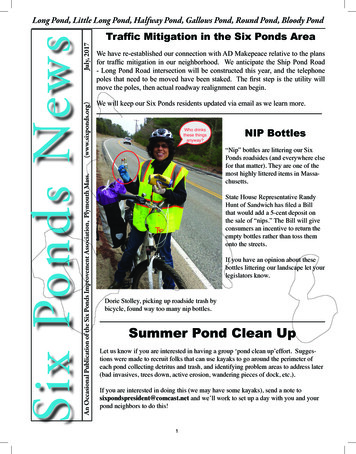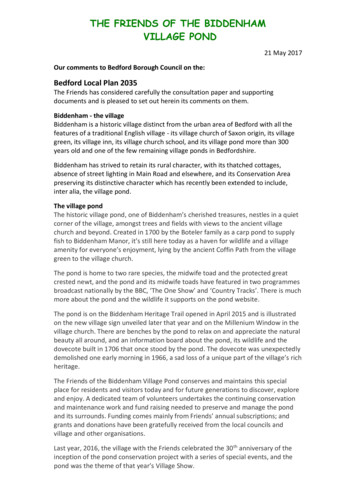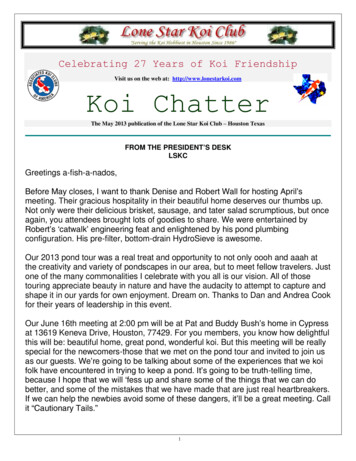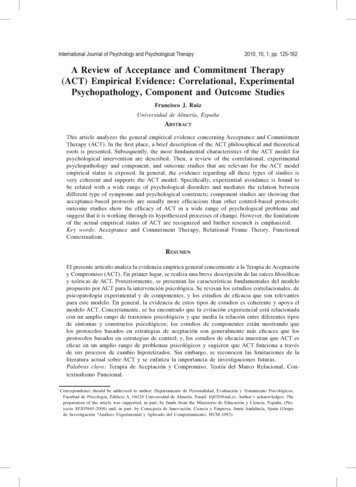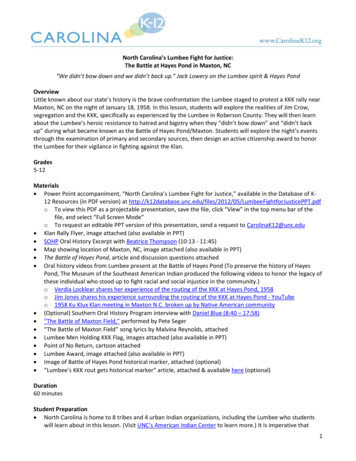
Transcription
North Carolina’s Lumbee Fight for Justice:The Battle at Hayes Pond in Maxton, NC“We didn’t bow down and we didn’t back up.” Jack Lowery on the Lumbee spirit & Hayes PondOverviewLittle known about our state’s history is the brave confrontation the Lumbee staged to protest a KKK rally nearMaxton, NC on the night of January 18, 1958. In this lesson, students will explore the realities of Jim Crow,segregation and the KKK, specifically as experienced by the Lumbee in Roberson County. They will then learnabout the Lumbee’s heroic resistance to hatred and bigotry when they “didn’t bow down” and “didn’t backup” during what became known as the Battle of Hayes Pond/Maxton. Students will explore the night’s eventsthrough the examination of primary and secondary sources, then design an active citizenship award to honorthe Lumbee for their vigilance in fighting against the Klan.Grades5-12Materials Power Point accompaniment, “North Carolina’s Lumbee Fight for Justice,” available in the Database of K12 Resources (in PDF version) at htforJusticePPT.pdfo To view this PDF as a projectable presentation, save the file, click “View” in the top menu bar of thefile, and select “Full Screen Mode”o To request an editable PPT version of this presentation, send a request to CarolinaK12@unc.edu Klan Rally Flyer, image attached (also available in PPT) SOHP Oral History Excerpt with Beatrice Thompson (10:13 - 11:45) Map showing location of Maxton, NC, image attached (also available in PPT) The Battle of Hayes Pond, article and discussion questions attached Oral history videos from Lumbee present at the Battle of Hayes Pond (To preserve the history of HayesPond, The Museum of the Southeast American Indian produced the following videos to honor the legacy ofthese individual who stood up to fight racial and social injustice in the community.)o Verdia Locklear shares her experience of the routing of the KKK at Hayes Pond, 1958o Jim Jones shares his experience surrounding the routing of the KKK at Hayes Pond - YouTubeo 1958 Ku Klux Klan meeting in Maxton N.C. broken up by Native American community (Optional) Southern Oral History Program interview with Daniel Blue (8:40 – 17:58) “The Battle of Maxton Field,” performed by Pete Seger “The Battle of Maxton Field” song lyrics by Malvina Reynolds, attached Lumbee Men Holding KKK Flag, images attached (also available in PPT) Point of No Return, cartoon attached Lumbee Award, image attached (also available in PPT) Image of Battle of Hayes Pond historical marker, attached (optional) “Lumbee’s KKK rout gets historical marker” article, attached & available here (optional)Duration60 minutesStudent Preparation North Carolina is home to 8 tribes and 4 urban Indian organizations, including the Lumbee who studentswill learn about in this lesson. (Visit UNC’s American Indian Center to learn more.) It is imperative that1
students understand the rich diversity of North Carolina’s tribes and cultures, both historically and theircontributions to communities around the state today.Students must understand expectations for respectfully discussing “hard history” such as Jim Crow andsegregation, which greatly impacted North Carolina’s diverse population of Native Americans. While thishistory brings up difficult topics, it represents a critical part of our shared state and national narrative thatstudents must understand in order to comprehend its impact on the present. To ensure students are ableto respectfully and empathetically discuss such topics, teachers must ensure a foundation of civildiscourse, respect and empathy in the classroom. For techniques on building such a classroom community,see Carolina K-12’s classroom management activities in the Database of K-12 Resources under the“Activities” section and specifically Tips for Tackling Sensitive History & Controversial Current Events in theClassroom.ProcedureThe KKK Target the Lumbee1.As a warm-up, project slide 2 of the accompanying PPT, which contains an image of a KKK rallyadvertisement. (Also attached, should teachers choose to print and distribute.) Discuss with students: What do you see here? What do you notice first when looking at this? (Encourage students to simplypoint out what information is contained in the image, what text first strikes them, etc.) What information does this give us? What do you think the purpose of this document was and why? What do you already know about the KKK? What comes to mind when you think of this hate group? Why do you think they are holding a “rally and cross burning” in Maxton, NC? The date is noted as January 18th. What year would you guess that this took place? What evidencemakes you think this? (As students infer various dates, many most likely provided past years, it isworth discussing that the KKK is still active in modern society and not just a hate group of the past.) Where is Maxton, NC?o Project the attached image of North Carolina, which has a red dot pinpointing the location ofMaxton. Ask students to try and identify the counties in which Maxton is located. (Robeson andScotland) Does anyone have a guess as to why the rally may have been held in this location? Who was the Klantargeting?2. Tell students that you are going to play a brief oral history clip from the Southern Oral History Program forthem that will offer some clues regarding the target of the Klan’s hate. Let students know that you aregoing to play a minute and a half excerpt from an interview with Beatrice Thompson, an African Americanfrom Charlotte, North Carolina who was born in 1955. Let the class know that while she is discussingsomething that happened in Charlotte, it clues us in to a campaign that the Klan was waging around thestate. Tell students that they should listen closely and write down any images that stick with them as theyhear her story. Start the clip at 10:13 and stop it at 11:45: https://soundcloud.com/sohp/beatricethompson?in ows. Afterwards discuss: What event does Beatrice Thompson describe? Why was the man targeted by the Klan? What struck you about what you heard? What images in particular stuck out for you as you listened?(Discuss images such as the fire from the cross mistaken as the sun; the image of a man weeping witha gun in his lap; etc. Teachers might also highlight the juxtaposition of the innocent aspect of childrengoing for ice cream on the same summer day that an innocent man is the victim of a hate crime.) What typically comes to mind when you consider who the KKK targeted/targets? (Students aresometimes familiar with the fact that the KKK targeted Black people, but are generally less familiarwith other targeted groups, such as North Carolina’s Tribal communities, including the LumbeeIndians.)2
3.Point out to students that while the account they heard took place in Charlotte, NC, the reason behind thecross burning was very similar to what was going on in Maxton, NC.4.Project slide 3 and explain to students that the rally the document refers to was held on January 18, 1958near Hayes Pond in Maxton, NC. During 1957 and 1958, many similar events were organized around thesame area, which held an almost evenly divided population of Lumbee Indians, African Americans, andWhites. Many of the Klan events, including the January 18th rally, were organized by South Carolina GrandDragon James “Catfish” Cole. In fact, five days before the rally on January 13, 1958, Klansmen burned across at the home of a Lumbee woman who was rumored to have a relationship with a white man. James“Catfish” Cole claimed that the January 18th rally would be attended by 5,000 heavily armed Klansmen, andthat the purpose of the rally was to remind the Lumbee Indians of “their place” in the racial order. Discuss: What emotions do you imagine Lumbee people would feel when they saw an advertisement like this?(Ensure students discuss emotions such as fear, anger, intimidation, anxiety, etc. Students, given theirmodern perspectives and lack of historical perspective, often jump to the conclusion that they wouldbe angered by the advertisement and would immediately fight back. However, in truth, to fight back inthe 1950s was often taking quite a risk. During the Jim Crow era, the Klan often got by with not onlypublic hate speech, but also acts of violence such as beatings and lynching. To stand up to them thenoften meant risking your life or the lives of those close to you. Even still, many people took this riskand did fight back in many ways, a further testament to their courage.) Cole had predicted that 5,000 heavily armed KKK members would participate at the rally. What do youpredict took place on that night?5.After students have shared their predictions, project the excerpt on slide 5 and read it out loud to peaktheir curiosity about the January 18th event: “The caravans rolled, like clockwork, every Saturday just after nightfall. Seven, sometimes eight cars.Sedans mostly, long and low, forming an unsettling parade that rolled up U.S. 74 from the south intoMaxton. Inside, the dome lights burned, casting the faces of passengers in an eerie, harsh glare. The KuKlux Klan wasn't known for subtlety. But it was known in this part of North Carolina. "You saw thosecars coming, and you knew who those men were," said Lillie McKoy, a former mayor of Maxton whogrew up watching the caravan from her uncle's store just outside town. "They wanted you to seethem. They wanted you to be afraid of them." And a lot of people were afraid .Until the Klan picked afight with people who fought back.” (Source:http://fayobserver.com/app/shared images/battle of maxton field/)Overview of the Lumbee Tell students that they will be learning about what actually took place on January 18, 1958 at the rally byHayes Pond in Maxton, NC. However, leave students with their curiosities peaked for a brief moment andexplain that before finding out what occurred at the rally, you first want them to learn a bit more aboutthe Lumbee. Ask students to share what they already know regarding the Lumbee and list their commentson chart paper. Further discuss the history and culture of the Lumbee. Some information is available onslide 6, and teachers can find additional and up to date information at: http://www.lumbeetribe.com/ https://americanindiancenter.unc.edu http://lumbee.web.unc.edu.The Night the Klan Met Its Match6.Pass out the attached article, The Battle at Hayes Pond, and instruct students to read it individually or inpartners. After reading the article, discuss: Why were Klan members terrorizing the Lumbee in the 1950s? Why were the Klan so concerned aboutpeople of differing races and ethnicities having relationships?3
o Teachers may want to remind students of Jim Crow laws, many of which dealt with“miscegenation” in North Carolina, meaning, people of different races marrying. For example,a 1953 Jim Crow statute stated that “marriage between white and Negroes or Indians void.Penalty: Infamous crime, four months to ten years imprisonment, fine discretion of court.”Cole predicted 5,000 Klansmen would show up to the rally. In actuality, how many Klansmen came?How many Lumbee came?How would you characterize the Lumbee who showed up at the rally to fight for their civil rights andlet the Klan know their message of hate was unwelcome?Why do you think so many Lumbee showed up to defend themselves? (It is important to discuss withstudents how it took active citizens who valued their rights to stand together and fight back. Had onlya few Lumbee showed up, things may have turned out differently. Explain to students that situationslike this don’t just happen accidentally; they require engaged citizens and thoughtful planning. Forexample, Simeon Oxendine was a Lumbee who had heard of Cole’s plans to host a rally and remindIndians of "their place in the racial order." Oxendine reportedly replied, "He said that, did he? We'lljust wait and see." Oxendine and others then organized to ensure there were many Lumbee there tolet the Klan know exactly how they felt about their message of hate. As one of the "elder statesmen"at the rally, Oxendine was one of several veterans who led the Lumbees.)Once the Klan was outnumbered, how did they respond? How would you characterize their response?What happened to Cole’s wife?o As the Klansmen dropped their guns and KKK paraphernalia, they scrambled into the woods sofast that many didn’t even notice what they left behind. Catfish Cole even left his wife behind!When the Lumbee showed up she panicked and drove into a ditch. It was the Lumbee whohelped push her car out and get her on her way while her husband hid out in the swamps,o Project slides 8 and/or 9 (also attached) of Lumbee holding a captured KKK flag from the rallyand ask students to respond to what they see. Explain to them that as the Klan retreated insuch haste they left behind all of the materials for their rally. Simeon Oxendine retrieved theblanket-sized KKK banner that was left behind and marched back to Maxton with it wrappedaround his body. His photo was taken and made the cover of Life magazine.How does the image in your mind of the Klan retreating in this way differ than many of the images wegenerally envision of the Klan? (The Klan is often portrayed as terrorizing, strong, powerful, dangerous,etc. – which are fair categorizations in the way they tormented innocent people, often withoutpunishment. However, in this instance we see a cowardly side to the Klan.)Why is this event such a victory for all people who were targeted by the Klan? (Explain to students thatthe Klan did not make another appearance in Robeson County until 1984, when a rally was held at aprivate farm. There were no incidents since there was visible law enforcement present.)Oral Histories from The Battle7. To preserve the history of Hayes Pond, The Museum of the Southeast American Indian produced thefollowing oral history videos to honor the legacy of these individuals who stood up to fight racial and socialinjustice in the community. Utilize one (or ideally, all) of these short clips to allow students to learn moreabout Hayes Pond, and related themes, from the direct participants in the event. Options include playingthe clip(s) for the entire class then discussing afterwards, or setting up listening stations around the roomand allowing students to explore the clips in small groups. Verdia Locklear shares her experience of the routing of the KKK at Hayes Pond, 1958o According to Mrs. Locklear, what was the Klan’s intention and why did she feel they had to fightback?o Does it surprise you to hear that they armed themselves? (Often, when teaching/learning aboutconflicts during the Civil Rights Movement, the narrative of non-violent passive resistance is theonly story told. In actuality, armed self-defense was also quite popular. Minoritized people foughtback in many ways, and it is important that students acknowledge the diverse strategiesemployed throughout the long Civil Rights Movement.)4
o We know that the Lumbee confiscated the Klan paraphernalia. According to Mrs. Locklear, whatdid they do with the crosses? How does this take on a different symbolism than what you usuallythink of when considering the image of a burning cross?o Summarize Mrs. Locklear’s experience of segregation. What impact do you think this had (and stillhas) on her? In what ways can we right the past wrongs of Jim Crow and segregation?o Mrs. Locklear jokes that “we had a ball,” but in reality what were they risking by making thecourageous decision to fight back?o What impact do you think the Lumbee’s actions at Hayes Pond had in the fight for justice?Jim Jones shares his experience surrounding the routing of the KKK at Hayes Pond - YouTubeo Why is Mr. Jones hesitant to return home for the rally? Why do you think he finally decides toattend?o How does Mr. Jones describe the atmosphere back at home?o Why do you think the Lumbee felt it important to arm themselves? (Often, whenteaching/learning about conflicts during the Civil Rights Movement, the narrative of non-violentpassive resistance is the only story told. In actuality, armed self-defense was also quite popular.Minoritized people fought back in many ways, and it is important that students acknowledge thediverse strategies employed throughout the long Civil Rights Movement.)o While the Lumbee came armed, they didn’t initiate violence against any of the Klan members andno one was shot. What does this say about the Lumbee and their level of restraint?o What impact does Mr. Jones note that their actions had on Klan activity overall?o What did this battle symbolize, according to Mr. Jones?1958 Ku Klux Klan meeting in Maxton N.C. broken up by Native American community with Jack Lowery(14:07)o What memories does Mr. Lowery share regarding segregation in Robeson County?o How did Mr. Lowery’s experiences with segregation influence his career decisions?o How does he describe the Lumbee spirit in regards to facing segregation, Jim Crow, and otherinjustices?o What strategies did the Lumbee employ to thwart Catfish Cole and the Klan?o What new details did you learn from Mr. Lowery’s first-hand account that you didn’t yet know?o Mr. Lowery notes that things could have turned out much differently at Hayes Pond than theydid. In what ways?Related: Southern Oral History Program interviews Daniel T. Blue (born 1949), Daniel Blue grew up inRobeson County, North Carolina, went to Duke Law School, and served as the Speaker of the NorthCarolina House of Representatives in the early 1990s, as well as a NC senator in 2009. From 8:40 to14:17, he shares his experiences as a Black man growing up in a tri-racial Robeson county, discussingsegregation and his defiance of Jim Crow. From 15:01 – 17:58, he shares memories of theconfrontation between Lumbee and the Klan. Questions to discuss if utilizing this clip:o How does he describe segregation in Robeson County? Did anything he share surprise you?Explain.o Where was the one place things weren’t segregated and why do you think this was the case?(The farm)o How many bathrooms were at the tobacco warehouses and why?o How does Mr. Blue answer when asked if segregation influenced him?o How did his attitude towards segregation change as he became a teenager? Even though hedescribes his defiance with a chuckle, what was potentially dangerous about this disregard?o What does Mr. Blue remember about the Battle of Hayes Pond? How does he describe theevent and its aftermath?Putting the Battle into Words7.Explain to students that when word of the KKK being defeated by the Lumbee spread, a folk singer choseto honor the event by writing a song about the occurrence. “Malvina Reynolds, a social activist and prolific5
songwriter, had had a personal encounter with what she called the ’bedsheet boys.’ According to herdaughter, Nancy Schimmel, Klan members broke into the Reynolds home in the early 1930s. They punchedReynolds and beat her husband and father. When she heard about the Klan's setback, Reynolds gleefullywrote a song, ‘The Battle of Maxton Field,’ which became a modest hit for folk singer Pete Seeger. In it, shepokes fun at the Klan's notion that the Indians ’aren't real Americans’ and they took off in fear whenconfronted.” (Source: www.lumbeetribe.com)8.Provide students with the attached copy of the song lyrics for students to read as they listen to the song.(Free recordings can typically be found by doing an internet search of “The Battle of Maxton Field, PeteSeger,” or a copy of the song can be purchased via an internet search for 0.99.)9.After students listen to the song, discuss: What is the mood of this song? How does it make you feel? What do you think Malvina’s purpose was in writing this song? What commentary does the song make regarding the Klan? Note specific lines to back up youranswers. What does Malvina mean when she says that Klansmen get their “courage from a spigot?” Who is the lonely KKK member left at the end of the song? Why does the song reference his wifebeating him? If you were to re-title this song, what would you call it and why? Why is it important to remember the Battle of Hayes Pond and to honor the Lumbee for such a braveresponse to hate? Consider the various ways we ensure that a particular history that we deem monumental or importantis not forgotten and is honored/celebrated. What are some other ways (such as in song) the Battle ofHayes Pond can be remembered? (Chart student thoughts on the board.)Putting the Battle into Art10. Teachers can also layer in the attached cartoon, “Point of No Return,” for students to view and discuss.(This is the image that Jack Lowery mentions in his account of events.) How is the Klan member portrayed in this image? How does this differ than the way the Klan was (and is) often presented? How does the spirit of this image compare to the spirit captured in the song? What overallcommentary does it make regarding the Battle of Hayes Pond?Award for Outstanding Community Member11. Project slide11 and explain to students that since the Battle of Hayes Pond, the Lumbee have maderemembering the event a priority. In fact, in January of 2008, the Lumbee Tribe of North Carolina and theIndian Honor Association celebrated the 50th Anniversary of the routing of the Ku Klux Klan from Maxton.The festivities were held at the Indian Resource Center in Pembroke. Tribal Chairman Jimmy Goinscommented, “This is just fantastic, to be able to honor our elders for their contributions and actions, whileeducating our youth on this historic battle”. The tribe and Honor Association believe it is important tohonor the ordinary people who stood up against bigotry and hatred, and to continue recognizing the braveLumbee who fought back that night. Project the attached image of the Lumbee award and share thefollowing with students: “The tribe actually started paying tribute to those who stood up to the Klan in July 2004. The tribehonored 146 Lumbee men and women during its annual homecoming celebration. Each received amedallion engraved with ’Lumbee Warrior‘ and ’1958‘surrounding the tribe's logo. Their names wererecently read in a January 2008 ceremony. "We want to take the time to honor these heroes whofought against the injustice and bigotry of the KKK," said Tribal Chairman Jimmy Goins.’They stood notjust for the Lumbees, but for all minorities.’’It is important for the tribe to remember the service of its6
forefathers,’ Alex Baker, the tribe’s public relations manager said. ‘We should never forget theircontributions that impact us today,’ he said. ‘It is because of them, people like me and others don'thave to feel the hatred of the KKK.’”Sources: http://fayobserver.com/app/shared images/battle of maxton -of-Hayes-Pond?Itemid 27&id 172&option com content&view article12. Discuss: What did the Tribal Chairman mean when he said, “We want to take the time to honor these heroeswho fought against the injustice and bigotry of the KKK. They stood not just for the Lumbees, but forall minorities "?According to Alex Baker, why is the tribe presenting awards for something that took place in the1950s? Do you agree or disagree with his comment that “It is important for the tribe to remember theservice of its forefathers. We should never forget their contributions that impact us today”? Explain.What do you notice about the award that was designed for the Lumbee who participated? (Encouragestudents to examine the attached image of the award and comment on the text, colors, etc. and tomake comments regarding what the award might stand for and mean to the people it was presentedto.)13. Project slide 12 and tell students that they will spend some time considering the importance of the actionsof the Lumbee. Tell them to imagine that there will be an awards ceremony this year to again honor those“ordinary people standing up to bigotry and hatred,” and that they have been selected to design theaward that will be presented to the Lumbee. Project and/or explain the following assignment:Congratulations! You have been selected to serve on a committee that will design an award to honorthe Lumbee who stood up for themselves and their community members at the January 18, 1958 Klanrally at Hayes Pond, NC. Being an active and engaged member of your community and fighting forjustice are special traits, and it is important to recognize those who dedicate themselves to such.Consider why the Lumbee did what they did, what they risked in taking such actions, and what theiractions meant for other minorities who had been harassed by the Klan. Then, design an award thatyou feel appropriately represents their contribution and honors what the Lumbee did on January 18,1958. The award you design can be a common award type (a certificate, a plaque, etc.) or can be morecreative and abstract (a statue, a physical shape symbolic of the Lumbee and their actions, etc.) Thepurpose is to be creative and show why the Lumbee are being honored with the design of your award.14. Students can complete this culminating activity in class or for homework. Teachers are encouraged todisplay the student created awards and allow the class time to view and discuss the various award designsonce they are turned in.Optional Activity15. On July 5, 2018, a historical marker honoring the Battle of Hayes pond was dedicated by the NCDepartment of Cultural Resources and the Office of Archives and History. Distribute the attached articleand have students read it aloud as a class. Discuss the following questions: What is the process for erecting a historical marker? Why do you think it was an easy decision for the historical commission to dedicate a marker to theBattle of Hayes Pond? Why do you think it took almost 60 years for a marker to be erected? Share the attached image. Ask students, what does the historical marker say?16. Assign one of the following or both activities to students:7
a. Design your own historical marker.You have been asked by the NC Department of Cultural Resources to design a historical marker forthe Battle of Hayes Pond. Unlike most historical markers, which are only one sentence, this onewill be 3-4 sentences. Use the following question to help guide your thinking when designing themarker: What do you think people should know about the Battle of Hayes Pond in 3 sentences?b. Write a dedication speech.You have been asked by the NC Department of Cultural Resources to give a speech at thededication ceremony for the Battle of Hayes Pond historical marker. Ask students to write a 3-5minute speech that explains the events of the Battle of Hayes Pond, explains why we shouldremember this event, and how it can relate to our lives today.8
Klan Rally AdvertisementSource: http://www.fayobserver.com/special/battle of maxton field/#9
Location of Maxton, NC10
The Battle of Hayes PondThe Battle of Hayes Pond refers to an armed confrontation between the Ku Klux Klan and Lumbee Native Americansnear Maxton, North Carolina on the night of January 18, 1958.During the 1950s, the Ku Klux Klan waged a campaign of terror throughout the American South. In 1957, KlanWizard James W. "Catfish" Cole of South Carolina began a campaign of harassment against his neighbors to thenorth, the Lumbee Indians of Robeson County, North Carolina. Declaring the Lumbee to be "mongrels," Cole toldnewspapers: "There's about 30,000 half-breeds up in Robeson County and we are going to have some crossburnings and scare them up."The new year began with a wave of Klan terror. On January 13, 1958, a group of Klansmen burned a cross on thelawn of a Lumbee woman in the town of St. Pauls, North Carolina as "a warning" because she was "having an affair"with a white man. The Klan held still more cross burnings while Cole traveled throughout the county speaking outagainst the "mongrelization" of the races.Pleased with the Klan's campaign of terror directed against the Lumbees, Cole planned a massive Klan rally to beheld on January 18, 1958, near the small town of Maxton, North Carolina. Cole predicted that 5,000 rallyingKlansmen would remind the Lumbees of "their place." Cole hoped that his efforts at cowing the Lumbee intosubmission would consolidate his control over the Klan in the Carolinas.“He said that, did he?” asked Simeon Oxendine, who headed the Lumbee chapter of the Veterans of Foreign Wars.Oxendine has flown more than thirty missions against the Germans in World War II. “Well, we’ll just wait and see.”Not surprisingly, Cole's speeches, particularly his inflammatory references to the "loose morals" of Lumbee women,provoked anger among the Lumbees. Robeson County Sheriff Malcolm McLeod went to see Cole and told him that"his life would be in danger if he came to Maxton and made the same speech he'd been making." Cole proceededwith his plans undeterred. He was convinced that a strong show of force would prove an unequivocaldemonstration of white supremacy and put an end to what he perceived to be rampant "race mixing" in RobesonCounty.On the night of the battle, only 50 Klansmen out of the planned 5,000 arrived at the designated rally point,gathering in a dark field alongside the road, lit only by a single bulb powered by a portable generator. However,before Cole could begin the rally, over 500 well armed Lumbee appeared, fanned out across the highway andencircled the assembled Klansmen. When Cole began to speak, a Lumbee smashed the light bulb with his riffle andthe hundreds of Lumbee gathered began making whooping noises and shot their riffles into the air.Panicked, the Klansmen scattered, abandoning their unlit cross and leaving their public address system and Klanregalia behind. Four Klansmen were wounded in the first volley fired by the Lumbee, but none were seriou
Project slide 3 and explain to students that the rally the document refers to was held on January 18, 1958 near Hayes Pond in Maxton, NC. During 1957 and 1958, many similar events were organized around the same area, which held an almost evenly divided population of Lumbee Indians, African Americans, and Whites.



